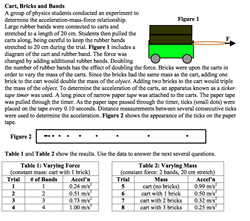 Cart, Bricks, and Bands
Cart, Bricks, and Bands
Resource:
Science Reasoning Center: Carts, Bricks, and Bands
Grade Level: High School
Description:
This passage describes a simple experimental design exploring the effect of varying mass and varying force upon an object's acceleration. Data is presented in the form of two figures and two tables. Questions target a student's ability to understand the experimental design, to identify appropriate conclusions that are consistent with the data, to select data from the provided set, to extrapolate from the provided data to predict the result of additional trials, to recognize proportional and numerical relationships, and to identify the graphical representations of the data.
Performance Expectation:
HS-PS2-1: Analyze data to support the claim that Newton’s second law of motion describes the mathematical relationship among the net force on a macroscopic object, its mass, and its acceleration.
This activity aligns with the three dimensions of the Next Generation Science Standards in the manner described below:
| Force and Motion (HS-PS2.A.1): Newton's 2nd Law accurately predicts changes in the motion of macroscopic objects. |
In this experiment, students investigate how changing the applied force and mass affects the acceleration of a cart. Trials 1-4 allow students to see how force affects acceleration; trials 5-8 allow students to explore how changing mass affects acceleration. As students analyze the entirety of these trials, they recognized that their investigations support the claim known as Newton’s 2nd Law of Motion. |
| Cause and Effect: Systems can be designed to cause a desired effect. |
As an example of a simple yet fundamental cause and effect relationship in physics, the student explores how varying force and mass (causes) lead to different rates of velocity change (effect). In questions that follow the experiment description and data presentation, the students are asked to recognize and apply this cause and effect relationship through predicting cart accelerations for new situations and in identifying conditions that will maximize acceleration. |
| Stability and Change: Change and rates of change can be quantified and modeled over very short or very long periods of time. Some system changes are irreversible. |
Contrary to Aristotle’s way of thinking that an object must feel at least some force to just maintain its motion, this experiment provides evidence that a force (whether big or small) will causes a mass (whether large or tiny) to change its velocity. The rate of change of velocity—known as acceleration—is illustrated with a dot diagram and measured as the dependent variable in this experiment. |
| Using Mathematical and Computational Thinking: Use a computational representation of phenomena or design solutions to describe and support claims and explanations. |
With a strong emphasis on computational thinking, over half the questions at the close of this passage ask students to use proportional reasoning, to graphically model data, and to interpolate. The computational reasoning in this passage does not require detailed mathematical calculations, but rather challenges students to glean simple mathematical relationships from data and then use these relationships to predict outcomes in new situations. |
| Obtaining, Evaluating, and Communicating Information: Critically read scientific literature adapted for classroom use to determine central ideas and obtain scientific/technical information. |
The task of reading for technical information is a critical skill for scientists and engineers. Questions 1, 4, and 9 require the reader to gather information from text and data presentations and then use this information to make a claim. |
Associated Reading from The Physics Classroom
Other Supporting Pages at The Physics Classroom:
View Infographic.
(Coming Soon)
Search the NGSS Corner
Maybe you're looking for something really specific that pertains to a desired topic and emphasizes one or more of the listed NGSS dimensions. Why not try a search of this section of our website? Simply select from one or more of the pull-down menus and click Search This page will reload and a collection of possibilities will be displayed in this section of the page and sorted by relevancy.